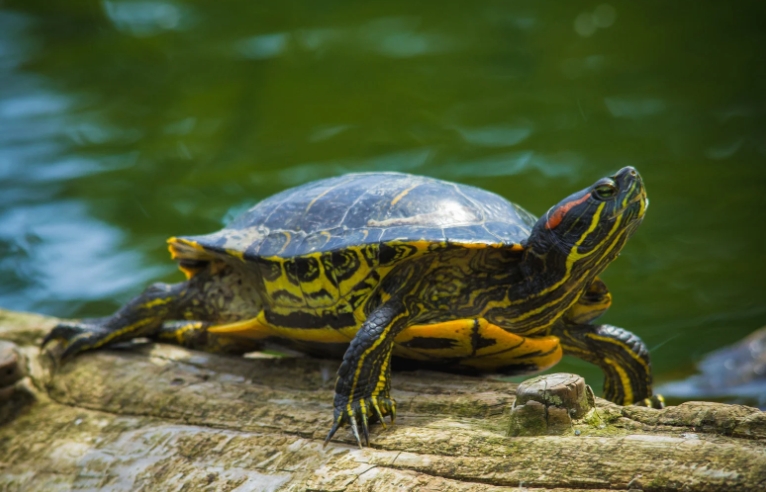How Big Does A Red-Eared Slider Turtle Get? A Deep Dive
Understanding the growth parameters and health requirements of red-eared slider turtles is essential for all potential and current pet owners. These turtles, known for their distinctive red markings around their ears, can make fascinating pets, but their size can impact their care. This article dives into how big does a red-eared slider turtle get, factors that affect its size, and tips for healthy growth.

What Is the Average Size of Red-Eared Slider Turtles?
Red-eared slider turtles can vary significantly in size depending on various factors. On average, adult females typically reach sizes of 10-12 inches, while males tend to be slightly smaller, usually ranging from 8-10 inches. It’s crucial to note that these measurements apply to turtles that are well cared for and provided with optimum living conditions.
What Factors Affect the Size of Red-Eared Slider Turtles?
Several elements contribute to the growth and ultimate size of red-eared slider turtles. Understanding these factors can help provide a better environment for your pet, encouraging healthy growth.
Diet: A balanced diet is critical. Turtles should be fed a mix of commercial turtle pellets, fresh vegetables, and occasional protein sources like insects or fish. Overfeeding can lead to obesity, while underfeeding can stunt growth.
Habitat: An adequate and clean habitat plays a significant role. A large tank with sufficient space for swimming and basking promotes physical activity, essential for growth.
Lighting: UVB lighting is a must for red-eared sliders. It helps them absorb calcium, vital for shell and bone health. Without proper lighting, turtles can suffer from metabolic bone disease, which impedes growth.
Water Quality: Clean water prevents infections and skin diseases. Use a strong filtration system, and ensure regular water changes.
Temperature: Both water and basking temperatures should be appropriately maintained. Around 75-85°F for water and 90-95°F for the basking area work best for these turtles.
How Can You Ensure Healthy Growth for Your Red-Eared Slider?
To ensure the healthy growth of your red-eared slider, it’s important to focus on a holistic approach that encompasses diet, habitat, temperature control, and regular veterinary care. By following these guidelines, you’ll give your turtle the best chance to thrive and reach its full potential size.
Balanced Diet: A well-rounded diet is essential for healthy growth. Red-eared sliders need a variety of foods to meet their nutritional requirements. Offer vegetables such as kale, dandelion greens, and collard greens to provide essential vitamins and minerals. Protein sources are also important and can be supplied through commercial turtle pellets, live insects like crickets, and occasional treats like earthworms. It’s crucial to avoid overfeeding, as obesity can lead to health problems.
Adequate Shelter: Your turtle’s environment plays a significant role in its development. A tank with both water and dry basking areas is necessary for healthy growth. Adult red-eared sliders require a tank that’s at least 50-75 gallons to provide enough space for swimming and exploration. Clean water is equally important to avoid bacterial growth that could lead to infections.
Optimal Temperature: Red-eared sliders are ectothermic, meaning they rely on external heat sources to regulate their body temperature. To maintain ideal conditions, use an aquarium heater to keep the water temperature between 75°F and 85°F. A basking lamp should be provided to maintain a basking area temperature of around 90°F, which is vital for digestion and overall health.
Regular Check-ups: Scheduling routine veterinary visits is essential to monitor your turtle’s health. Turtles are prone to various health issues, including parasitic infections, which can slow growth. Regular fecal exams can detect parasites, and early treatment can prevent further complications. Additionally, a veterinarian can assess your turtle’s growth and provide advice on diet or habitat adjustments.
What to Expect When Your Red-Eared Slider Reaches Full Size?
When a red-eared slider turtle reaches its full size, certain changes and maintenance routines must be anticipated to ensure it continues to thrive.
Increased Space Needs: As turtles grow, their tank size needs to be adjusted accordingly. Crowded environments can cause stress and stifle growth.
Feeding Adjustments: Adult turtles have different nutritional needs compared to juveniles. They can be fed every few days rather than daily, and their diet should lean more towards vegetables and less towards proteins.
Health Monitoring: Full-sized turtles might face different health issues. Regular monitoring for shell integrity, eye clarity, and appetite is essential.
Behavioral Changes: Mature turtles may become less active or more territorial. Understand and accommodate these changes to foster a stress-free environment for your pet.
Conclusion
Red-eared slider turtles make fascinating pets, with their growth dependent on diet, habitat, and overall care. How big does a red-eared slider turtle get depends on various factors. Understanding their average size and ensuring proper care can lead to a healthy, thriving pet. By establishing a conducive environment and adhering to best practices, you can ensure your red-eared slider grows to its full potential and remains a healthy companion.
FAQs
How long does it take for a red-eared slider to grow full size?
A red-eared slider typically reaches its full size, around 6 to 12 inches in shell length, in 5 to 7 years. Growth is rapid in the first few years, then slows down. Proper care, a balanced diet, and an optimal habitat are essential for healthy growth during this period.
Do red-eared sliders need a big tank?
Yes, red-eared sliders require spacious tanks. An adult turtle needs a tank that’s at least 50-75 gallons to ensure sufficient space for swimming and basking.
